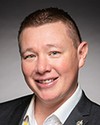Madam Speaker, there are three distinct groups that make up aboriginal people under the Constitution of Canada, which are the Métis, the first nations and the Inuit. They are represented by the Assembly of First Nations, Inuit Tapiriit Kanatami and the Métis National Council.
We made sure we heard from these voices, but we wanted to make sure this was a non-political group. We did not want parties to come in and say that they really liked an organization and wanted a certain person to have a seat or that they really like what another person had to say. We tried to keep the politics out of it, stick with the constitutional nature that is represented in section 35 and make sure that we were consistent with what we were putting forward with the Constitution of Canada and the United Nations Declaration on the Rights of Indigenous Peoples. That is why we have moved forward with those three groups.
As part of the committee and part of the discussion, we heard some great discussion about the need to include indigenous women as part of our calls to justice in the aid of missing and murdered indigenous women and girls. We believed that because of gender parity, because of the things we wanted to do to show them we were moving forward on the calls to justice, we would move forward with the Native Women's Association of Canada. However, those were the only groups we felt were the appropriate—

